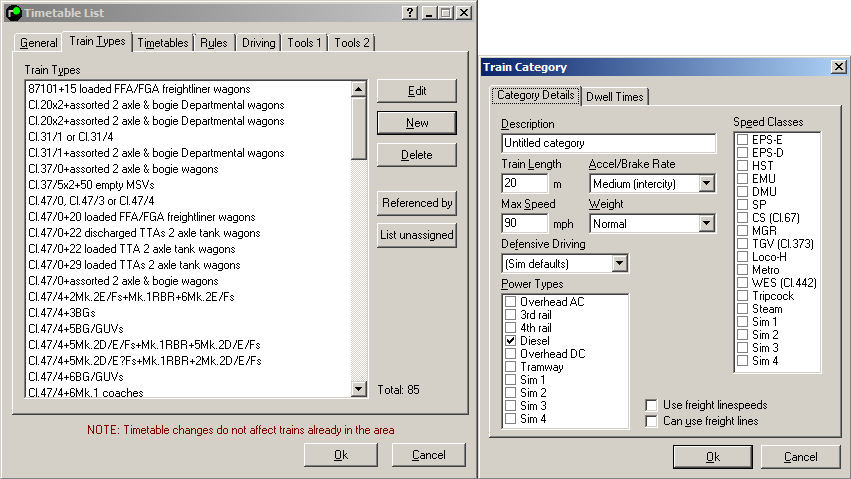Table of Contents
TimeTable List, Train Types TabSpeed Classes
Within the Timetable Editor
Initial Power
Class of Service
TimeTable List, Train Types Tab
Note: These pages are based on Loader simulations. Non-Loader simulations may not have all features shown here.

For details of real-life train classes, please see Locomotive Characteristics and Multiple Unit characteristics .
The New, Edit and Delete buttons are self-explanatory. Clicking the 'Referenced By' button will display a list of all trains using the highlighted Train Type, and 'List Unassigned' produces a list of trains that have not been allocated a train type.
=
Train Category
Description - The name of the train type, and (if applicable), the number of carriages, e.g. Class 150 4-Car.
Train Length - The length of the train in metres.
Accel/Brake rate - The speed at which the train can speed up and slow down.
Max Speed - The Maximum speed of the train.
Use Freight linespeeds - If ticked, the train will use speeds specified for freight trains, where applicable.
Can use freight lines - If ticked, this will allow class 1, 2 and 9 trains to use freight lines without questioning the route. Note- if 'Use Freight linespeeds' is ticked, this box need not be ticked.
Weight - Enables finer control of the Acceleration/Braking performance of the train.
Power Types- The types of power the train can use. Diesel, 25kV AC Overhead, 750V DC 3rd rail, and London underground 4th rail are the most commonly used, but provision exists for DC overhead, Tramway and simulation-specific types should the need for them arise.
Defensive Driving - The Defensive Driving rules that the train works to. Rule sets can be created in the Driving tab.
Dwell Times - Follow link
Speed Classes
Tick the relevant boxes if the train should use alternative speed limits, where featured in the simulation.
| Speed Class | Description |
|---|---|
| EPS-E | Enhanced Permitted Speed for electric trains with tilting capabilities (currently only Class 390 'Pendolino' and APT) |
| EPS-D | Enhanced Permitted Speed for diesel trains with tilting capabilities (currently only Class 221 'Super Voyager') |
| HST | For High Speed Trains , Class 91+Mk.4 coaches, and certain types of multiple unit |
| EMU | For Electric Multiple Units |
| DMU | For Diesel Multiple Units |
| SP | For 'Sprinters' (Classes 150, 153, 155, 156, 158 and 159) and 'Sprinter-like' trains (Classes 165, 166, 168, 170, 171 and 172) |
| CS | For Class 67 hauled trains |
| MGR | For 'Merry-go-Round' coal trains |
| TGV | For class 373 |
| Loco-H | For trains hauled by a locomotive |
| Metro | For Metro trains |
| WES | For 'Wessex Electric' units (Class 442) |
| Tripcock | For trains fitted with London Underground Tripcock aparatus |
| Steam | For steam hauled charter trains in the modern era. May not be appropriate for pre-1968 timetables. |
| SimX | Individual Sim-specific classes, see individual manual for useage |
Within the Timetable Editor
The following options are selected in the Train Characteristics tab of the Timetable Editor , and do not appear in the generic 'Train Type' page.
Initial Power
Used to select which type of power the train has available to use. If the train switches between AC and DC (for example) mid-journey without an activity, both AC and DC should be ticked here.
Class of Service
Simsig attempts to automatically categorise a train into one of five classes. These decide how scoring applies to items such as delays and incorrect platforming, what types of delay the train can suffer, and how the departure time of the train works.
From version 4.3 of the Loader, a new system was implemented to determine the class. More information on the default rules and the ability to provide custom rules for a specific timetable is provided here .
The class can be overridden for each train individually on the Misc page, under "Class of service".
| Back to Timetable List |
|---|
Created by AndyG 20/11/09
Last edited by Jan on 11/03/2018 at 19:34